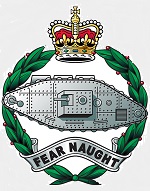Forces of Valor 81201 British Matilda Mk. II Infantry Tank - Unidentified Unit, North Africa, 1941 (1:32 Scale)
"After [El] Alamein, we never had a defeat."
- British Prime Minister Winston Churchill
 The Mark I Matilda was developed in response to a 1934 requirement for a close-support infantry tank. Well armored for its day, it was, nevertheless, a small, simple tank. Despite being sturdy enough to withstand hits from most German tank guns in the early stages of WWII, it was too poorly armed to be of much use as the war progressed. The Mark II had improved armament, which enable it to stand up well in combat, particularly in North Africa where it was widely used in the run-up to the Battle of El Alamein in 1942. Following its replacement in frontline service, the Matilda was used for a variety of specialized roles, such as mine-clearing (the Baron), as a flamethrower tank (the Frog), and as the basis of a Canal Defense Light for illuminating night operations.
The Mark I Matilda was developed in response to a 1934 requirement for a close-support infantry tank. Well armored for its day, it was, nevertheless, a small, simple tank. Despite being sturdy enough to withstand hits from most German tank guns in the early stages of WWII, it was too poorly armed to be of much use as the war progressed. The Mark II had improved armament, which enable it to stand up well in combat, particularly in North Africa where it was widely used in the run-up to the Battle of El Alamein in 1942. Following its replacement in frontline service, the Matilda was used for a variety of specialized roles, such as mine-clearing (the Baron), as a flamethrower tank (the Frog), and as the basis of a Canal Defense Light for illuminating night operations.
Pictured here is a 1:32 scale British Matilda Mk. II infantry tank that was deployed to North Africa during 1941.
Sold Out!
Dimensions:
Length: 7-1/2-inches
Width: 3-1/4-inches
Height: 3-1/2-inches
Historical Account: "Supercharge" - The Siege of Tobruk was a lengthy confrontation between Axis and Allied forces, mostly from the Australian 9th Division, in the North African Campaign of World War II. It started on April 10th, 1941, when Lieutenant General Erwin Rommel's Afrika Korps attacked the fort, besieging it for 240 days.
The Australian commander, Lieutenant General Leslie Morshead divided the 50 kilometre (30 mile) perimeter into three rough sectors. It would be the job of the three Australian brigades to ensure these were not breached. The 26th would hold the western sector, the 20th would hold the south and the 24th would hold the east. The 9th Division was reinforced by the Australian 18th Brigade (detached from the 7th Division) and British artillery units. Morshead also ordered all Italian signal cables to be re-laid. He wanted to know what was happening, and where, so he could adjust his forces accordingly. He also kept a reserve of runners in case the telephone lines were disrupted by the German attack.
At 4:00 AM on April 10th, 1941, during one of the most fierce khamsin (sandstorm) in a generation, a patrol from the Australian 2/48th Battalion (9th Division) discovered that they were being trailed by a German panzer. They succeeded in losing the tank before they got back to Tobruk. This alerted the Australian forces to the threat of the coming assault.
The first shots in the defence of Tobruk were fired using captured Italian field guns, by members of the 2/28th Infantry Battalion, who had been given one week's training in the use of artillery. They observed three German armoured cars closing in on their position.
General Heinrich von Prittwitz und Gaffron was near the front line, supervising troops of the German 8th Machine Gun Battalion attacking a slope that led to a destroyed bridge. He made a good target for Australian gunners; he and his driver were among the first casualties and both were killed. The skirmish lasted for three hours until the Germans finally fell back. Australian sappers and engineers hastily laid minefields.
Rommel decided to sweep past Tobruk, cutting the main Bardia Road to Cairo and investing the city. However, because of Allied naval superiority, the Allied troops were never short of supplies, and wounded troops could be ferried out of the city. The siege of the city was done with three Italian Infantry Division and the Italian Ariete Armour Division as well as elements from the 5th Light Division , under General Kircheim, the only German division under Rommel's command. (Courtesy: Wikipedia)








![USAF General Dynamics F-16CG Viper Fighter - 8th Fighter Wing Commander's Jet "Wolf Pack", Kunsan Air Base, South Korea, 2007 [Low-Vis Scheme] (1:72 Scale)](http://cdn4.volusion.store/qh9e9-jdqv9/v/vspfiles/photos/HA3846-1.jpg?v-cache=1740197136)
